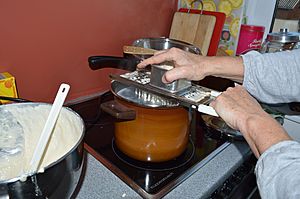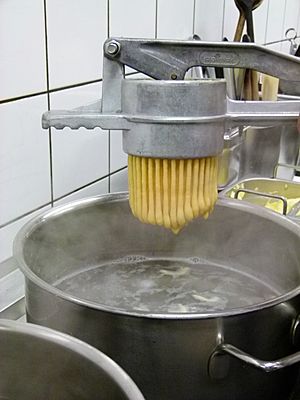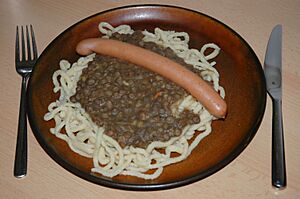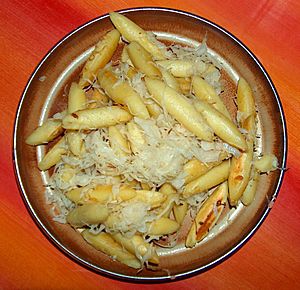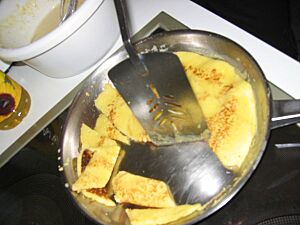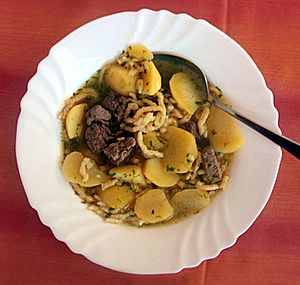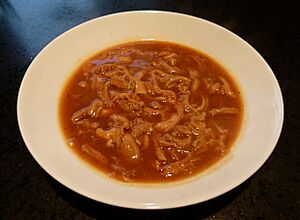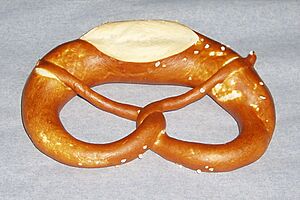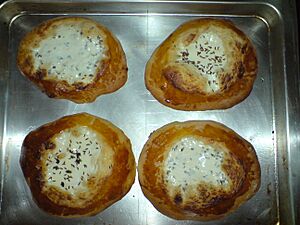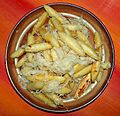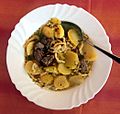Swabian cuisine facts for kids
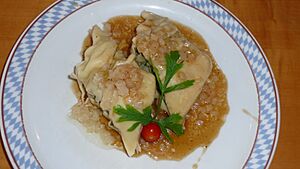
Swabian food comes from Swabia, a region in southwestern Germany. This area includes parts of Württemberg and the Bavarian part of Swabia, plus the Allgäu region, which even stretches into Austria.
Swabian cooking is known for being simple but very tasty and filling. You'll often find fresh egg pastas like Spätzle noodles or Maultaschen dumplings. Soups and sausages are also very popular. Swabian dishes usually have broths or sauces, so they are rarely "dry."
Contents
A Look Back at Swabian Food
In the past, the soil in Swabia wasn't very good for raising cattle. This meant that meat was a luxury, mostly eaten by rich people and landowners. Regular people often ate cheaper parts of animals, like tripe.
Different parts of Swabia had their own cooking styles. In Old-Wurttemberg, people were very religious, so their food was simple. They cared more about getting enough to eat than about fancy flavors. But in Catholic areas of Swabia, especially those influenced by Austria, the food was richer and had more dishes made with flour.
In the Hohenlohe Plains, fish, especially carp, was a favorite. Cities like Ulm, Augsburg, Ravensburg, and Biberach had very mixed cuisines, with ideas from Italy and France.
Potatoes arrived in the mid-1600s and quickly became popular. Many new recipes were created, such as Schupfnudeln, potato salad, and home fries. Even today, many people think of traditional Swabian food as simple, hearty "farmhouse food."
Noodles and Dumplings
Some of Swabia's most famous dishes are Maultaschen (dumplings filled with meat and spinach) and Spätzle (fresh egg noodles). These fresh noodle dishes come in many forms and can be main meals or side dishes.
Maultaschen: The "God-Cheaters"
Maultaschen are dumplings filled with ground meat, onion, spinach, and old bread. They have a funny nickname: Herrgottsbscheißerle, which means "little God-cheaters." The story goes that monks first made them to hide meat during Lent, a time when they weren't supposed to eat meat. They thought God wouldn't see the meat inside the pasta!
Maultaschen can be served in a tasty beef broth or fried. While eaten all year, they are traditionally eaten on Good Friday.
Spätzle and Knöpfle: Versatile Noodles
Another very famous Swabian food is spätzle. Swabians use spätzle as a side dish for almost any meat dish with sauce. They are also the main ingredient in many stand-alone meals. When served with meat, they are often topped with roasted onions and breadcrumbs browned in butter.
A popular dish with spätzle as the main ingredient is Kässpätzle. This dish uses spätzle cooked in salted water, then layered in a baking dish with different kinds of cheese (like Emmentaler or Gruyère) and roasted onions. The type of cheese used depends on the region.
Like many noodle dishes in Central Europe, spätzle can also be sweet. They can be served with sugar, apple sauce, or other fruit preserves. However, they are more commonly found in savory dishes.
Linsen mit Spätzle is another original Swabian dish. It features lentils cooked in a vinegar broth and served over spätzle. This dish is often served with Vienna sausages or smoked bacon.
Spätzle can be made by scraping fresh pasta dough in thin strips from a "Spätzlesbrett" (a simple wooden board). Today, special "Spätzlepresse" tools (like potato ricers) are often used. Shorter Spätzle and thick, round Knöpfle are made with a "Spätzlehobel," a board with small holes that pushes the dough directly into boiling water.
Spätzle and Knöpfle are usually tossed in melted butter before serving. The dough is made from wheat flour, egg, and water. Sometimes, ingredients like spinach or tomato puree are added for color.
Schupfnudeln: Potato Noodles
Also called Buabaspitzla, Schupfnudeln are special to Upper Swabia and the Allgäu. They are made from a dough with equal parts flour and potato. They have an oblong shape with pointed ends. They are cooked by boiling in salted water. They can also be pan-fried with sauerkraut and bacon, a dish called "Krautschupfnudeln" (cabbage schupfnudeln). This is often eaten during carnival and at the Kermesse festival. Schupfnudeln can also be served sweet, either pan-fried or boiled, with melted butter, cinnamon sugar, apple sauce, or fruit preserves.
Pancakes: Flädle and Kratzete
Pancakes are also called Flädle in Swabia. They are usually very thin and fried in oil. You can eat them whole with savory or sweet toppings, or cut them into strips and add them to soups.
Another type of pancake is Kratzete. These are not only eaten as a sweet dish but can also be served with asparagus.
Soups and Stews
Soups and stews are a very important part of Swabian food. Swabians love them so much that they are sometimes called Subbaschwôb, which means "Soup Swabian." In fancy restaurants, soups are usually served as a starter. But in homes, they are often a main meal, served with bread.
Gaisburger Marsch: The Marching Stew
One of the most popular Swabian stews is Gaisburger Marsch. It's a hearty stew with diced beef, cooked potatoes, and Spätzle. The special touch is fried onions on top. The story says that this stew was first served to hungry soldiers in Gaisburg in the 1800s. It became so popular that soldiers from far away would march to Gaisburg just to eat it. That's why its name means "March to Gaisburg."
Flädle Soup: Pancake Strips in Broth
Thin pancakes are cut into slices and added to a clear broth. Since they soak up the broth quickly, they are added just before serving.
Meat and Fish Specialties
Even though meat wasn't used much in the past, there are still some regional meat dishes. For example, roast lamb with spätzle. Many recipes use tripe (animal stomach), which was cheap and easy for everyone to get. A well-known dish (though not loved by everyone) is Saure Kutteln. This is tripe cut into slices, cooked with a thick sauce, and then made sour with vinegar or wine.
Other famous dishes using animal organs are "Saure Nieren" (sour kidneys) and "Saure Leber" (sour liver). Both are made by slicing the offal, pan-frying it, and serving it with a sauce, often with spätzle or home fries and a green salad.
The Swabian Wurstsalat is a salad made from sliced sausages mixed with onion, pickles, and chives. It's dressed with oil and vinegar and eaten with bread.
Fish dishes often use Bodenseefelchen, a freshwater fish from the salmon family caught in Lake Constance. They are often pan-fried in butter, but can also be steamed or smoked.
Other Swabian Dishes
Filderkraut is a special type of Sauerkraut. It's made from a unique pointed cabbage grown on the Fildern Plains near Stuttgart.
The Swabian potato salad is very famous in Germany and beyond. Unlike the mayonnaise-based potato salad in Northern Germany, it is lighter and has less fat. Waxy potatoes are cooked and peeled while still hot. Then they are sliced and mixed with diced onions. Warm broth, vinegar, and oil are poured over them. You can add chives or diced pickles, or spice it with mustard. The salad should sit for a few hours or even overnight before serving. It's great as a side dish or just with bread.
Brenntar was a very important food in Swabia, especially in the Swabian Jura and the Allgäu. It's made from a specially roasted flour called Musmehl.
Sweet Dishes
Ofenschlupfer (meaning "oven slipper") is a type of bread pudding. It's made with old white bread, sugar, vanilla, and cinnamon. These are layered in a baking dish with apples, raisins, and almond biscuits. Then, it's soaked in an egg and cream-based custard and baked in the oven.
Kirschenplotzer uses old white buns mixed into a dough with butter, egg, milk, and sugar. Cherries are folded into the dough before it's baked in a casserole dish and served hot.
Pfitzauf is another dish baked in the oven. It's a type of soufflé made in special Pfitzauf molds. It's usually served with applesauce or vanilla sauce, but there are also savory versions with cheese or bacon.
Nun's puffs are small, round doughnuts made from a yeast dough or choux pastry and fried. They are traditionally eaten during Carnival. They can be a main dish or a dessert, served with icing sugar, cherries, or vanilla sauce.
Beignets are also very famous and are often made with apples and served with vanilla sauce.
Baked Goods
Bread and Pastries
Swabian baking has a wide variety of breads. Many are only baked in specific areas or villages. However, some baked goods are found throughout the region and are widely available in bakeries. These include Laugengebäck (like pretzels), bread rolls, and Hefezopf (a braided yeast bread).
The Swabian "Seele" (meaning "soul") is a white bread similar to a baguette, originally from Upper Swabia. It's made from a very wet dough of spelt flour, yeast, water, and salt. It's shaped into a long loaf and sprinkled with caraway seeds and coarse salt. After baking, it's crispy outside and very light and fluffy inside. It stays moist because spelt flour has a lot of gluten.
Briegel is a similar baked good from East Wurttemberg, and it's even moister than the Seele. It belongs to a group of moist breads like Wasserwecken and Knauzen from Wendlingen.
Another specialty from Reutlingen is the Dreikönigsmutschel (meaning "Three Kings Mutschel"). It's a star-shaped, plain yeast pastry with eight points and a round raised center. It's traditionally eaten on the Thursday after Epiphany. People often play dice games to win and eat it as part of a celebration.
Savory Cakes
The Swabian Cream Cake is a thin, flat yeast bread spread with sour cream and topped with onion or leek and bacon. It's very similar to Flammkuchen from Alsace. The toppings can change; some add egg or caraway seeds. In the Heilbronn area, a version called "Peterlingkuchen" (parsley cake) is popular, topped with parsley. The name for this flatbread also changes depending on the place, with variations like Dennetle, Dinnette, Blooz, and Bätscher.
Also well-known is the Swabian Zwiebelkuchen (onion cake), which is very similar to the French quiche Lorraine. It's usually eaten in late summer and autumn with Federweisser (new wine) or apple cider.
Sweet Cakes
Many different cakes are made in Swabian homes. This is because Germans often have "Kaffee und Kuchen" (coffee and cake) on Sunday afternoons, and Swabians love this tradition. The Swabian Träubleskuchen is also very popular. It's a cake with a shortcrust pastry base and a filling of redcurrants and beaten egg whites.
Images for kids
-
Swabian Maultaschen
-
Schupfnudeln with sauerkraut
See also
 In Spanish: Gastronomía de Suabia para niños
In Spanish: Gastronomía de Suabia para niños


